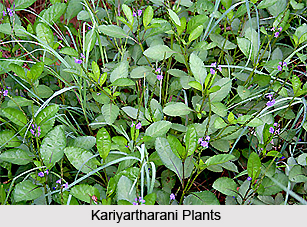 Kariyartharani is an Indian medicinal plant with several remedial properties. The scientific name of Kariyartharani is Stachytarpheta jamaicensis. There are several other common names of this medicinal plant. Like for instance, in English it is known as Aaron`s rod and Jamaica false vervain. In Kannada, Kariyartharani is called as kadu uttarani, kariyuttarani and uttirani. It has several other names also, in Malayalam it is known as katapunuttu and kattapunuthu; in Oriya it is called jalajali and in Tamil, Kariyartharani is called as naioringi, simainaivirunji and simainayuruvi. This medicinal plant is a native of tropical America and naturalized in the Asian tropics. However, it is found as a weed across India and is occasionally cultivated.
Kariyartharani is an Indian medicinal plant with several remedial properties. The scientific name of Kariyartharani is Stachytarpheta jamaicensis. There are several other common names of this medicinal plant. Like for instance, in English it is known as Aaron`s rod and Jamaica false vervain. In Kannada, Kariyartharani is called as kadu uttarani, kariyuttarani and uttirani. It has several other names also, in Malayalam it is known as katapunuttu and kattapunuthu; in Oriya it is called jalajali and in Tamil, Kariyartharani is called as naioringi, simainaivirunji and simainayuruvi. This medicinal plant is a native of tropical America and naturalized in the Asian tropics. However, it is found as a weed across India and is occasionally cultivated.
Kariyartharani is an erect, glabrous, dichotomously branched annual or perennial herb, usually 30 to 90 cm high. Its young branches are almost quadrangular, leaves are oblong-elliptic, generally 5 to10 cm long and around 2.5 to 3.8 cm wide, apex acute or obtuse, margins coarsely serrate, its base tapering and decurrent (that is extending downward) into the obscure petioles. The flowers sessile of this plant borne in long, slender, nearly continuous glabrous spikes up to 30 cm long, the rachis hollowed out beneath each flower; bracts or plant structure is around 5 mm long, lanceolate, subulate. Further, it is membranous, tubular, short and acute and is generally of corolla deep blue or purple colour. Kariyartharani also bears pear-shaped and ribbed fruits (capsules), of around 3 to 4 mm long, enclosed in the calyx, breaking into 2 oblong pyrenes; seeds black, flattened.
Kariyartharani has got various medicinal properties. This herb is used for treating intestinal worms, venereal diseases, ulcers, and erysipelas, dropsy and stomach ailments. A decoction of the plant is said to be used as an abortifacient. Further, it has been also used to stop vomiting. The juice of the leaves is used to remove cataracts. The leaves are rubbed on sprains and bruises or used as a cataplasm for boils, and their decoction is used to treat ulceration of the nose. An infusion of the bark is used to relieve diarrhoea and dysentery. In Brazil the plant is used externally to treat purulent ulcers and internally for treating fevers and rheumatic inflammation.



















